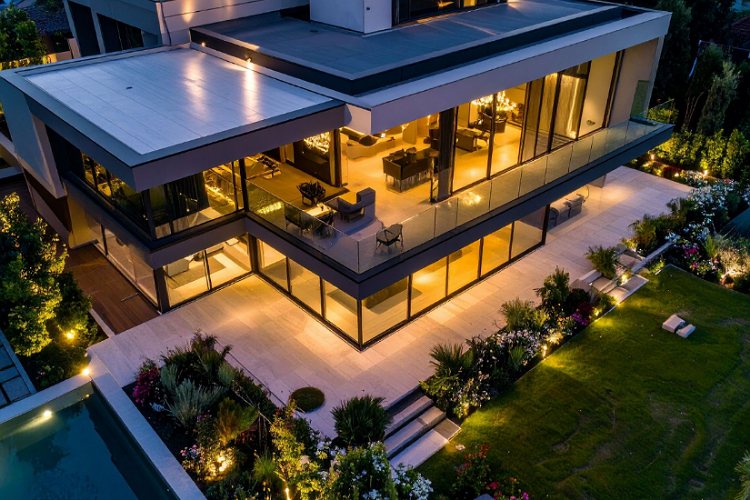Look, building your dream home is thrilling, but let’s be honest, the sheer number of choices can hit you like a freight train. Everything from your home’s footprint down to those tiny cabinet pulls? Yeah, it all counts. Here’s the silver lining: you’re not flying solo on this one. When you’ve got a solid roadmap and genuine expert backup, you can work through custom home design decisions step by step, dodge expensive mistakes, and wind up with a house that actually fits how you live.
Custom housing starts hit 184,000 homes over the last four quarters, that’s a 2% bump from before, proving more folks are embracing personalized homes even with all the complexity.
Pre-Design Phase: Setting Your Foundation Right
Before you even think about paint swatches or bathroom tile, there’s crucial groundwork that needs your attention. These early calls set the tone for literally everything else.
Getting Your Budget and Priorities Straight
Your budget isn’t just construction numbers. Land purchase, permits, landscaping, furniture, it all adds up fast. Most builders will tell you to tack on a 10-15% buffer for those “surprise” moments that always seem to happen.
Start by splitting things into two camps: absolute must-haves and the nice-if-we-can-swing-it items. Maybe that gourmet kitchen is non-negotiable for you, but the bonus room? You could take it or leave it.
This hierarchy becomes your lifeline when tough money decisions pop up. A good budget calculator breaks everything down: foundation work, framing, finishes, mechanical systems, and site prep.
Choosing Your Lot Wisely
Colorado Springs’ terrain is all over the map, flat lots with killer mountain views and sloped properties that need some engineering creativity. Your topography directly shapes what’s possible with design and what construction will cost you. Steep slopes might mean serious grading or designing for a walkout basement.
Solar orientation? More important than you’d think. South-facing windows grab that passive solar warmth in winter, and the right overhangs keep summer heat in check. When you partner with seasoned builders like Elk Ridge Custom Homes, you get expert insight into how your specific lot characteristics will influence design choices.
Since they have built all over Colorado Springs, they understand local conditions intimately, drainage patterns, energy efficiency factors, all of it, and how these elements impact every corner of your new home.
Assembling Your Dream Team
Do you need a separate architect, or would a design-build firm make more sense? Design-build companies bundle everything, design and construction, under one umbrella. It usually means fewer crossed wires and faster timelines.
Dig into portfolios and find a team whose style clicks with your vision. Look at actual finished projects, not just pretty renderings. Understanding the decision workflow upfront saves frustration down the road. You’ll want clarity on when choices need to lock in and how changes get managed.
Architectural Design Decisions Before Building a House
Foundation’s set? Great. Now it’s time to shape your home’s character and layout. These decisions before building a house echo for years.
Selecting Your Home’s Style
Your architectural style should vibe with both the lot and neighborhood while staying true to your taste. HOA rules might fence you in on exterior materials or colors, so check those early. Mountain contemporary works beautifully around Colorado Springs, though traditional and craftsman styles hold strong, too.
Think timeless over trendy. Classic proportions and solid materials age gracefully, while overly trendy touches can feel stale in ten years. Your exterior palette, stone, siding, brick, and stucco, impacts aesthetics and maintenance. Roof pitch influences interior volume and determines snow load capacity.
Figuring Out Square Footage
Here’s an interesting trend: homeowners are gravitating toward sleek bathroom designs featuring walk-in, doorless showers. These aren’t just pretty; they marry form and function, and popularity jumped by 4 points recently.
Calculate what you actually need space-wise instead of picking an arbitrary number. Room-by-room requirements depend on your lifestyle. Future-proofing counts.
Will you eventually want a main-floor bedroom? Cost per square foot climbs with custom features, but smaller, smart designs often feel roomier than larger, poorly planned spaces.
Planning Vertical Space
Single-story homes win for aging-in-place and eliminating stair worries, but they eat up more land. Multi-story designs use smaller lots efficiently and naturally separate living zones. Playing with ceiling heights adds drama, vaulted ceilings open up living areas, while standard heights make bedrooms cozy.
Staircase placement matters for traffic flow. Central stairs connect spaces well, but consume prime square footage. Foundation choice, basement, crawl space, or slab, hinges on soil conditions, budget, and storage needs.
Creating Natural Traffic Flow
Open concepts are still hot, but totally open plans can feel undefined. The best layouts strike a balance between openness and zones. Think about natural movement through your home. Primary zones usually include public spaces (living room, kitchen), private areas (bedrooms), and service zones (laundry, garage entry).
Sight lines matter for beauty and practicality. Can you keep an eye on the kids outside while cooking dinner? Indoor-outdoor flow changes how you use your home, especially with Colorado’s 300 sunny days.
Essential Custom Home Design Decisions by Room Category
Let’s dig into specific spaces where you’ll live your life. These custom home planning tips focus on high-impact zones.
Kitchen Design Framework
Your kitchen layout affects daily life more than almost anything else you’ll choose. The classic work triangle (sink, stove, fridge) still holds up, but modern work zones accommodate multiple cooks better. Island size should balance prep space, seating, and traffic; don’t go so big that it blocks circulation.
Appliance packages span from basic builder-grade to professional. Let your cooking habits guide this call. Walk-in pantries offer amazing storage but need 6×6 feet. Butler’s pantries hide prep chaos when you’re entertaining.
Storage solutions, pull-outs, drawer organizers, appliance garages, keep your counters breathing. Countertop material involves durability, upkeep, and looks. Quartz is a low-maintenance, natural stone that brings a unique character.
Primary Suite Planning
Your primary bedroom should genuinely feel like a retreat. Size and orientation count. Are you a morning sun person, or do you prefer darker mornings? A bathroom setup with a separate shower and tub, dual vanities, and private toilet areas makes life easier for couples.
Custom closet systems squeeze every inch of value. Walk-ins need proper dimensions, 8×10 feet minimum for two people. Private outdoor access to a deck or patio extends your sanctuary. Spa touches like heated floors, steam showers, and soaking tubs elevate everything. Think about laundry proximity, too. Having laundry near your primary closet beats hauling clothes across the house.
Building a Custom Home Checklist: Structural Elements
A thorough building a custom home checklist tackles structural and systems choices that can’t easily change later.
Foundation and Framing
Foundation type depends on soil and design goals. Traditional lumber framing stays cost-effective; engineered lumber offers consistency. Load-bearing wall placement affects future flexibility; fewer bearing walls means easier remodeling later.
Considering future additions? Plan structural support now. Structural insulated panels (SIPs) deliver superior insulation and air-sealing but need specialized installation.
Window and Door Strategy
Window sizing dramatically impacts natural light and energy bills. Bigger windows mean views and light, but more heat loss. Energy-efficient options include low-E coatings and argon fills. Door locations should follow natural traffic patterns and accessibility.
French doors versus sliders? Space and style preference. French doors need swing clearance; sliders work in tight spots. Different window styles suit different rooms, casement windows seal tight, and double-hung windows offer traditional appeal.
Modern Custom Home Planning Tips: Smart Technology
Technology infrastructure requires planning before drywall goes up. These custom home planning tips prevent costly retrofits.
Smart Home Infrastructure
Whole-home automation controls lighting, climate, security, and entertainment from one interface. Structured wiring with CAT6 cable and conduit for future upgrades ensures flexibility. Plan thermostat spots and HVAC zones for optimal comfort and efficiency.
Security camera spots should cover entry points and valuable areas without privacy invasion. Voice control integration needs power and network access. Electric vehicles in your future? Plan for 240-volt charging station wiring now.
Lighting Design
Layered lighting mixes ambient, task, accent, and decorative fixtures. This gives you flexibility for different activities and moods. Recessed lighting needs careful spacing; too many look like a Swiss cheese ceiling, and too few leave dark patches.
Dimmer controls and scene programming adjust lighting throughout the day. Exterior lighting zones boost security and curb appeal. Natural daylight through skylights and light tubes cuts electric lighting needs.
Energy Efficiency and Sustainability
High-performance building choices pay back through lower bills and better comfort.
Building Envelope Performance
Insulation packages beyond code requirements slash energy costs significantly. Air sealing and proper vapor barriers stop moisture problems and drafts. High-efficiency windows with Low-E coatings and quality frames minimize heat transfer.
Blower door testing measures actual air leakage and spots problems before they’re hidden. Good insulation and air sealing often beat expensive mechanical systems for return on investment.
HVAC System Selection
System comparisons should factor Colorado’s climate; heat pumps work well in moderate temps, traditional furnaces handle extreme cold better. Zoning systems let you heat or cool areas independently.
Fresh air ventilation maintains healthy indoor air without wasting energy.
Ductwork design and sealing prevent waste. Leaky ducts in unconditioned spaces waste 20-30% of your heating and cooling energy.
Interior Finishes That Define Your Style
When designing your own home, material selections create the daily experience you’ll enjoy for years.
Flooring Strategy
Hardwood provides timeless beauty and durability. Species, grade, and finish all affect appearance and cost. Large-format tile creates modern looks with fewer grout lines. Carpet versus hard surfaces in bedrooms? Personal preference and allergy considerations.
Plan transitions between flooring materials carefully; awkward transitions kill flow. Heated floors in bathrooms and entryways deliver luxury and comfort during Colorado winters.
Cabinet and Millwork
Cabinet construction quality varies wildly. Plywood boxes outlast particleboard. Door style and finish should coordinate throughout for visual continuity. Hardware seems minor, but it affects daily usability and aesthetics.
Crown molding, baseboards, and trim profiles add architectural interest. Built-ins maximize functionality while adding character. Paint-grade versus stain-grade wood depends on the desired look and budget.
Your Path to Custom Home Design Success
The journey of making custom home design decisions might feel overwhelming, but breaking it into phases makes everything smoother. Each choice builds on what came before, creating a cohesive home reflecting your lifestyle and values.
Working with experienced pros transforms this complex process into an enjoyable, creative collaboration.
The time you invest in thoughtful planning prevents expensive changes and ensures you’ll love your home for decades. These decisions ultimately create more than a house; they create the backdrop for your life’s most important moments.
Common Questions About Custom Home Design
1. How long does the design decision process typically take?
Most custom home design phases run 3-6 months, depending on complexity and how fast you make selections. Working with experienced builders who provide clear decision timelines streamlines everything significantly.
2. What’s the most expensive design decision when building?
Square footage typically drives the biggest cost, followed by finish quality and site conditions. Adding 100 square feet costs roughly $15,000-$30,000, depending on finish levels throughout.
3. Can I change decisions after construction starts?
Some changes are still possible during construction, but they trigger change orders with cost and schedule impacts. Structural decisions lock in earliest; paint colors stay flexible longer. Early planning minimizes expensive mid-construction changes.

